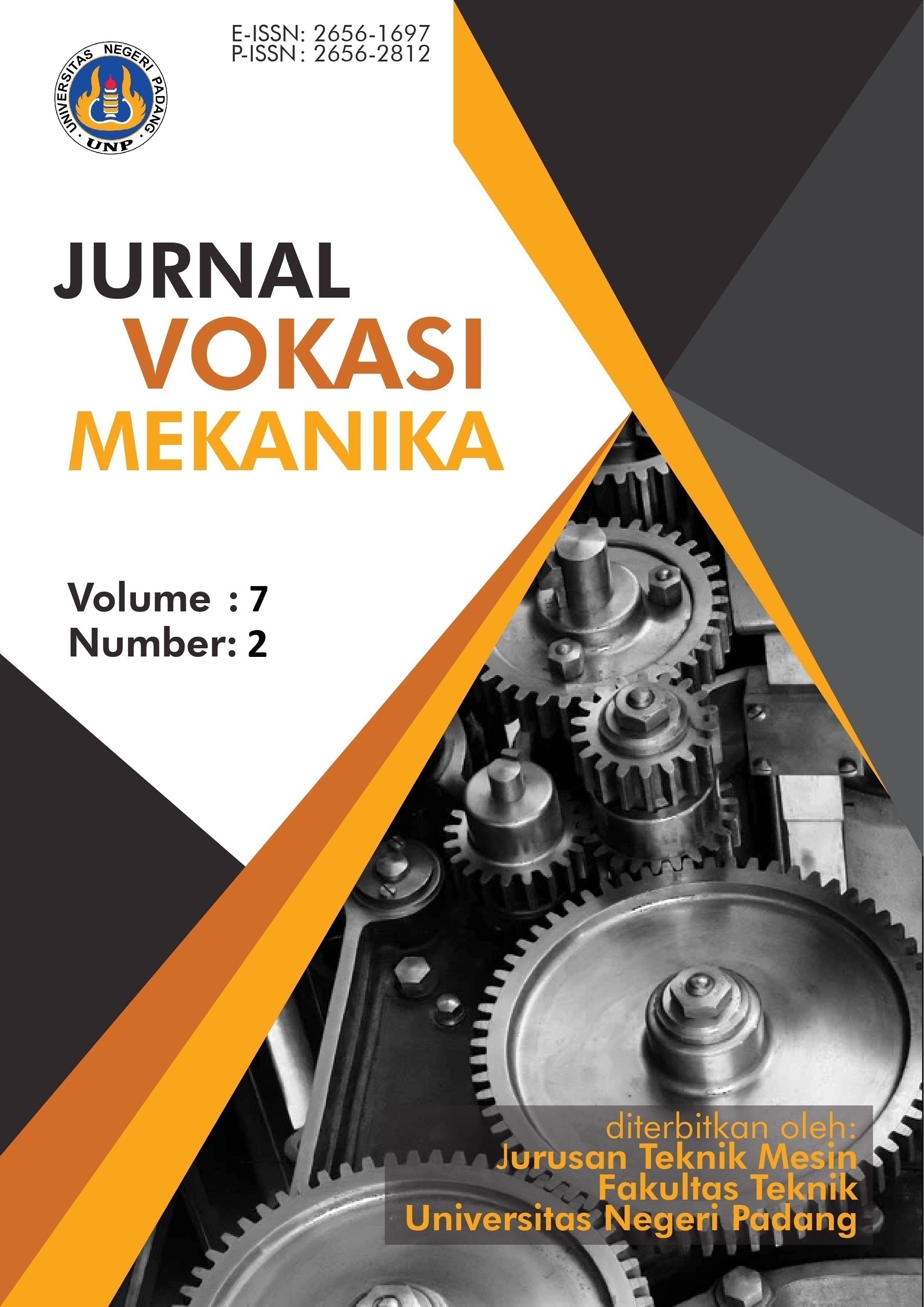Analysis Thermal for Disc Brake Using Finite Element Analysis (FEA)
Abstract
Traffic accidents are one of the highest causes of death in Indonesia. One of the factors traffic accidents is caused by vehicles, in this case the braking system. Brakes are a device on a vehicle that functions to reduce the speed by applying friction. The main feature in the braking system is heat dissipation. If the brake overheating, the effectiveness of the braking system will be reduced. In general, there are two types of brakes, but in modern vehicles disc brake more used. In this study, various types of disc brakes will be tested. The designs tested are solid disc brakes, drilled-type disc brakes, and grooved-type disc brakes. The aim of research for determine the most optimal disc brake design. The temperature value on the surface of the disc brake will be measure. The Finite Element Analysis (FEA) method is used in this study. The validation process is carried out by comparing analytical result and Finite Element Analysis result on solid disc brakes. The speed before braking is 60 km / h. Material used on disc brake is grey cast iron. In the simulation process using Finite Element Analysis, the mesh size used is 3 mm and the number of elements is 255,244 elements. After the analysis was carried out, the temperature value in the grooved-type disc brake design was the smallest value than another with a maximum temperature of 143.56 ºC during braking. Thus, based on the results obtained, the grooved-type disc brake tends to be more optimal.
References
Adhitya, M., Siregar, R., Sumarsono, D. A., Nazaruddin, Heryana, G., Prasetyo, S., & Zainuri, F. (2020). Experimental analysis in the test rig to detect temperature at the surface disc brake rotor using rubbing thermocouple. Eastern-European Journal of Enterprise Technologies, 2(5–104), 6–11. https://doi.org/10.15587/1729-4061.2020.191949
Afivie, R. W., & Kartika, A. A. G. (2023). Analisis Kecelakaan Lalu Lintas pada Ruas Jalan Slamet Riyadi-Supriadi Kabupaten Jember. Jurnal Teknik ITS, 12(3), 179–186. https://doi.org/10.12962/j23373539.v12i3.127367
Balaji, V., Lenin, N., Anand, P., Rajesh, D., Bupesh Raja, V. K., & Palanikumar, K. (2020). Brake squeal analysis of disc brake. Materials Today: Proceedings, 46, 3824–3827. https://doi.org/10.1016/j.matpr.2021.02.046
Belhocine, A. (2015). Numerical Simulation of Thermoelastic Contact Problem of Braking Systems. Journal of Failure Analysis and Prevention, 15(6), 932–940. https://doi.org/10.1007/s11668-015-0039-0
Budynas, R. G., & Nisbett, J. K. (2015). Shigley’s Mechanical Engineering Design (V. Bradshaw, Ed.; Tenth Edition). McGraw-Hill Education.
Day, A., & Bryant, D. (2022). Braking of Road Vehicles (E. Thomson, Ed.; Second Edition). Butterworth-Heinemann.
Dubale, H., Paramasivam, V., Gardie, E., Tefera Chekol, E., & Selvaraj, S. K. (2021). Numerical investigation of thermo-mechanical properties for disc brake using light commercial vehicle. Materials Today: Proceedings, 46, 7548–7555. https://doi.org/10.1016/j.matpr.2021.01.437
Gillespie, T. D. (2021). Fundamentals of Vehicle Dynamics (S. Taheri, Ed.; Revised Edition). Society of Automotive Engineers. Inc.
Kristiyanto, D. A., Widodo, A., & Kurdi, O. (2023). Analisis Deformasi dan Tegangan Pada Friction Block Kereta Api Cepat Dengan Bentuk Heptagon Menggunakan Finite Element Method. JURNAL TEKNIK MESIN, 11(4), 215–218. https://ejournal3.undip.ac.id/index.php/jtm/article/view/41869
Kuciej, M., & Grzes, P. (2011). The Comparable Analysis of Temperature Distributions Assessment in Disc Brake Obtained Using Analytical Method and FE Model. Journal of KONES Powertrain and Transport, 18(2), 235–259. http://yadda.icm.edu.pl/baztech/element/bwmeta1.element.baztech-article-BUJ5-0039-0030
Limpert, R. (1999). Brake Design and Safety (Second Edition). Society of Automotive Engineers. Inc.
Qomaruddin, Q., Khoeron, S., Setiawan, H., Hidayat, T., & Setyawan, M. (2024). Studi Tentang Strategi Pendinginan dan Manajemen Termal Pada Permukaan Cakram Saat Peengereman Dengan Menggunakan ANSYS. Jurnal CRANKSHAFT, 7(3), 34–42.
Setiazi, T., Tauviqirrahman, M., & Muchammad, M. (2022). Analisis Elemen Hingga Karakteristik Suhu Solid Disc Brake Mobil. JURNAL TEKNIK MESIN, 10(4), 547–550. https://ejournal3.undip.ac.id/index.php/jtm/article/view/36223
Sivaprakasam, P., Abebe, E., Čep, R., & Elangovan, M. (2022). Thermo-Mechanical Behavior of Aluminum Matrix Nano-Composite Automobile Disc Brake Rotor Using Finite Element Method. Materials, 15(17). https://doi.org/10.3390/ma15176072
Topczewska, K., & Zamojski, P. (2020). Effect of Pressure Fluctuations on the Temperature during Braking. Acta Mechanica et Automatica, 14(2), 103–107. https://doi.org/10.2478/ama-2020-0015
Yevtushenko, A., & Kuciej, M. (2020). A Method to Account for Thermal Sensitivity and Friction Heat Resistance of Materials in Calculating Disc Brake Temperature Mode. Journal of Friction and Wear, 41(3), 221–227. https://doi.org/10.3103/S1068366620030058
Submitted
Copyright (c) 2025 Jurnal Vokasi Mekanika (VoMek)

This work is licensed under a Creative Commons Attribution 4.0 International License.








.svg_.png)


